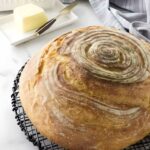Easy Sourdough Bread Recipe
This is an easy sourdough bread recipe using your natural sourdough starter. This can be baked in a dutch oven or on a sheet pan for equally great results.
Servings: 1 loaf
Ingredients
- ⅔ cup active sourdough starter (160 grams)
- 1⅓ cups warm water (314 grams)
- 4¼ cups all-purpose flour (510 grams)
- 2 teaspoons salt (12 grams)
Instructions
Mix the dough
- In a large bowl, combine the sourdough starter, warm water, flour, and salt. Stir with a spatula or your hands until no dry spots remain. The dough will be sticky and shaggy. Cover the bowl with a damp towel or plastic wrap and let it rest for 30–45 minutes.
Stretch and fold and Bulk Rise
- After the rest, perform the first stretch and fold: with wet hands, grab one side of the dough, stretch it upward, and fold it over the center. Rotate the bowl and repeat 3 more times for a total of 4 folds.
- Repeat this process 2 more times, spaced 30 minutes apart, for a total of 3 rounds. After the final fold, cover the bowl and let the dough rise at room temperature until puffy and nearly doubled in size, about 4 to 6 hours, depending on the temperature.
Shape and proof
- Turn the dough out onto a lightly floured surface. Gently shape it into a round by folding the edges toward the center and flipping it over. Use your hands or a bench scraper to tighten the shape slightly.
- Place the dough seam-side up in a floured proofing basket or towel-lined bowl. Cover and refrigerate for 8 to 12 hours for a cold fermentation that develops more flavor and makes scoring easier.Short on time? You can skip the fridge and let the shaped dough rise at room temperature for 1 to 3 hours, or until it looks slightly puffy and airy. See the note below about signs that the bread is ready to bake.
Score and bake
- Place a Dutch oven with the lid on into the oven and preheat to 475°F. Let it heat for at least 30 minutes to ensure the pot is thoroughly hot.
- Remove the dough from the fridge and invert it onto a sheet of parchment paper. Score the top with a sharp knife or lame.
- Carefully transfer the dough (on the parchment) into the hot Dutch oven. Cover and return it to the oven. Lightly spritz the surface of the dough with water. This encourages extra steam in the pot and helps create a crisp, blistered crust.
- Bake covered for 20 minutes, then uncover and bake for another 20–25 minutes, or until the crust is deep golden and crisp. Transfer to a wire rack and let the loaf cool completely before slicing.
Notes
Stretch and fold vs. kneading: This recipe uses stretch-and-folds to gently build structure, but you can also knead the dough the traditional way. After mixing, knead for 8–10 minutes until smooth and elastic, then let rise until nearly doubled before shaping and chilling.
Cold fermentation adds flavor: Letting the dough rest in the fridge overnight helps develop deeper flavor and makes scoring easier.
Not much rise? No problem: It’s normal if the dough doesn’t rise much in the fridge. If it still feels dense and not quite puffy, let it rest at room temperature for 30 to 60 minutes before baking to finish proofing.
Room temperature matters: Warmer environments will speed up the rise, while cooler temps slow it down. If your kitchen is chilly, you can place the dough in a warm room like the laundry room while the dryer is running. Slower fermentation often results in better flavor.
Weigh for accuracy: For consistent results, use a kitchen scale instead of measuring cups. Flour weight can vary a lot when measured by volume.
Handle with care: Avoid adding extra flour when kneading or shaping. Too much flour will lead to dense bread.
Proofing baskets: Dust generously with a 50/50 blend of rice flour and all-purpose flour. Rice flour helps prevent sticking, but on its own it can be too loose and slippery.
No banneton? No problem: You can use a medium mixing bowl or colander lined with a well-floured tea towel.
No Dutch oven? No problem: You can bake this loaf on a preheated pizza stone or a baking sheet instead. Just know the crust may not be quite as crisp without the trapped steam.
Extra steam tip: For a slightly higher rise and better crust, spritz the shaped dough with water just before baking. This adds moisture to the hot Dutch oven and boosts steam.
About the salt: Some recipes delay adding salt until after the initial rest, but in this recipe, the salt goes in at the start. It keeps things simple and the results are consistently great.
Signs your dough is ready to bake: Gently press a floured finger into the dough about ½ inch deep. If the indentation springs back slowly and leaves a slight dent, the dough is ready to bake. If it springs back quickly, it needs more time to rise. If it doesn’t spring back at all and feels very soft, it may be slightly overproofed, but you can still bake it.
After a cold proof, the dough may feel firmer and the poke test can be less obvious. If you're unsure, let it rest at room temperature for 30–60 minutes, then check again.
Nutrition
Serving: 1slice | Calories: 72kcal | Carbohydrates: 55g | Protein: 2g | Fat: 0.2g | Sodium: 155mg | Fiber: 0.5g | Sugar: 0.1g
